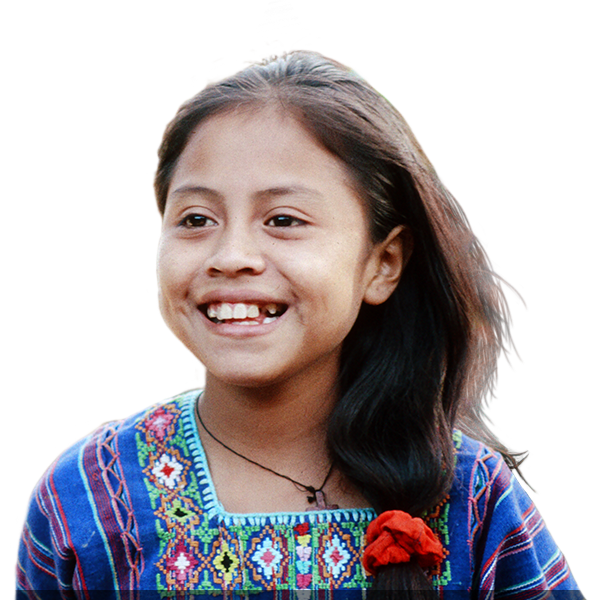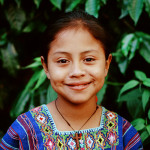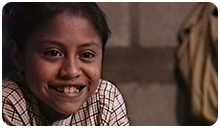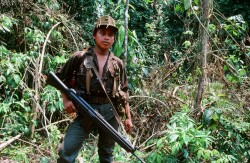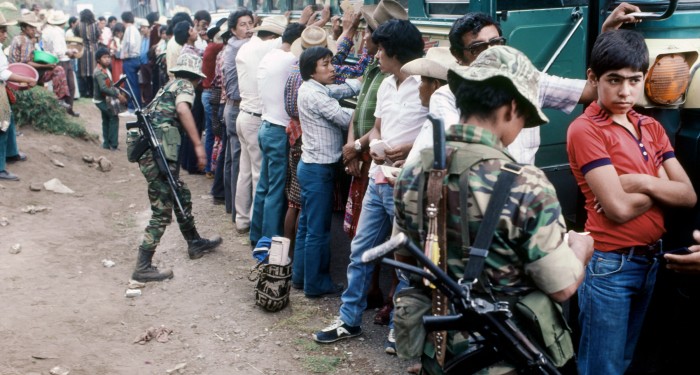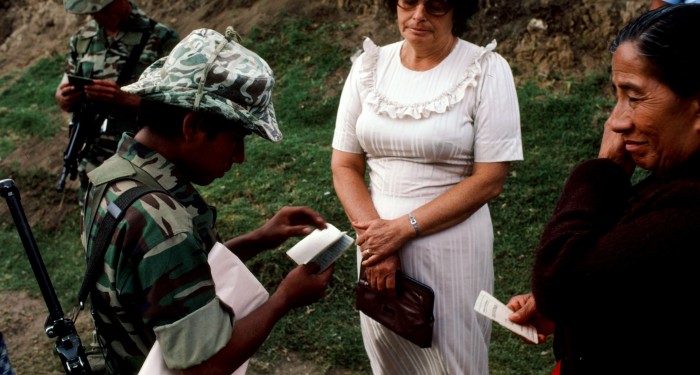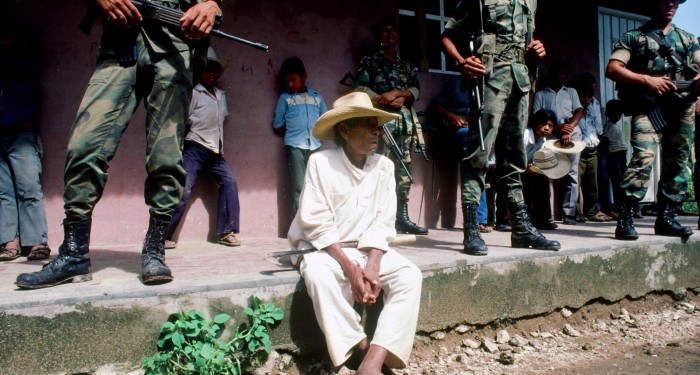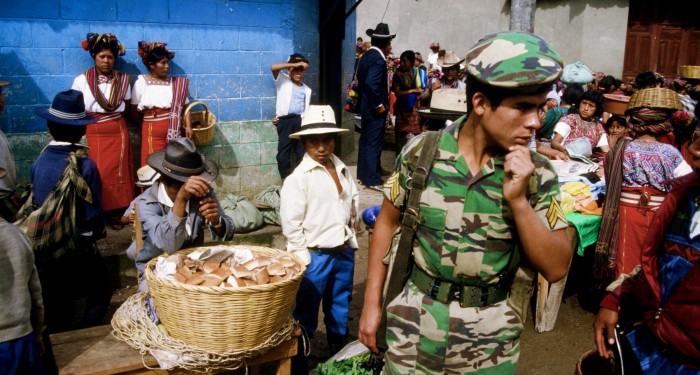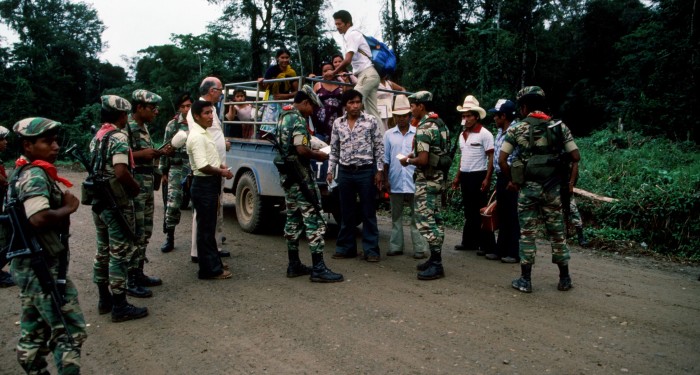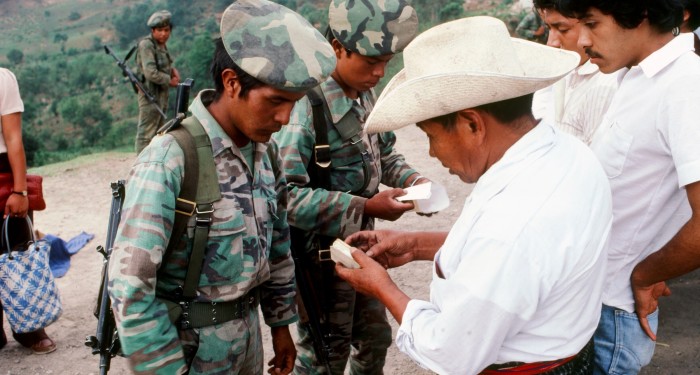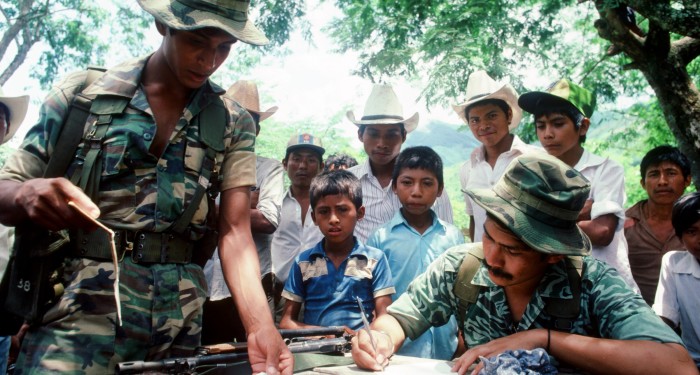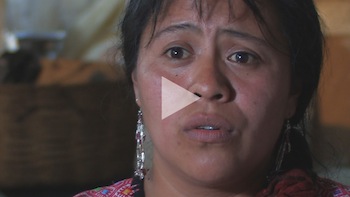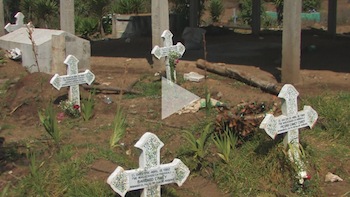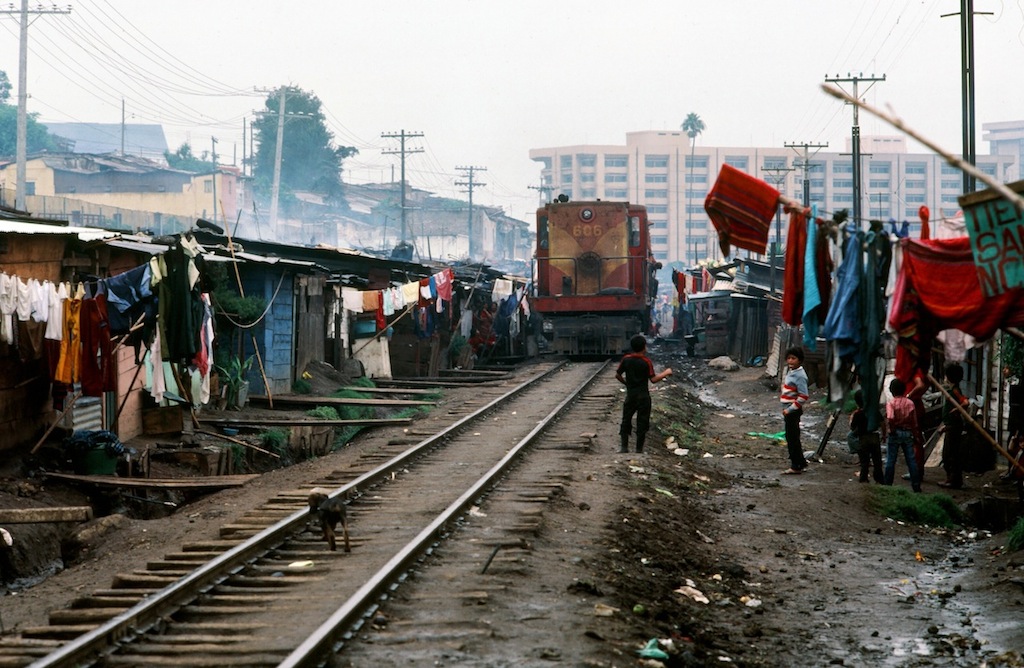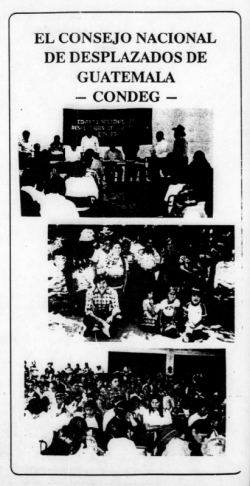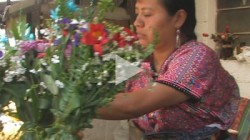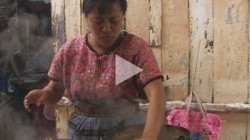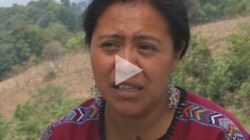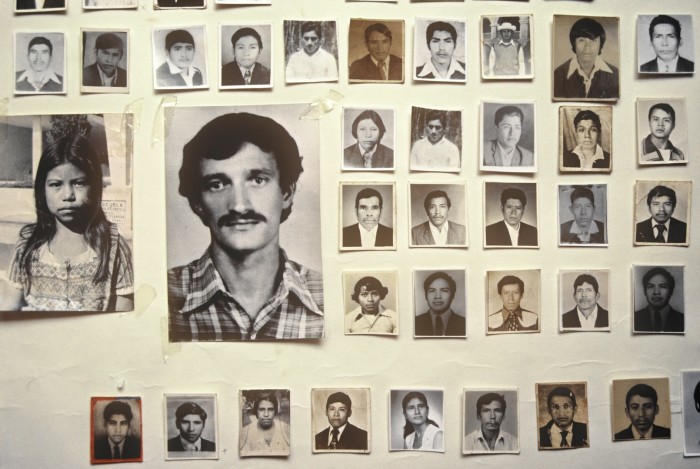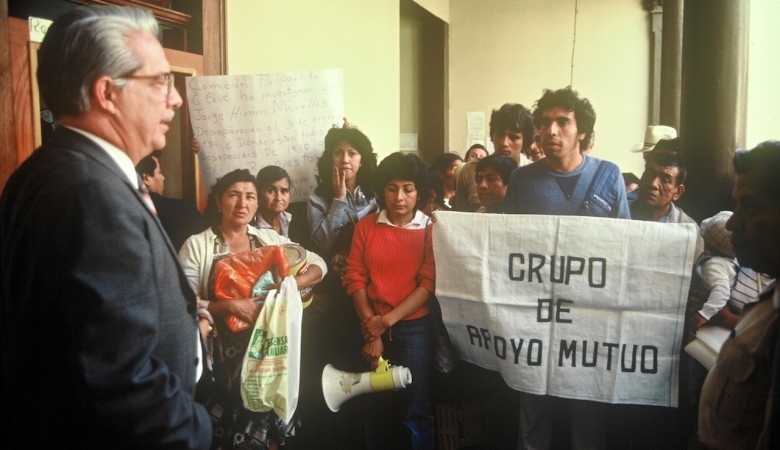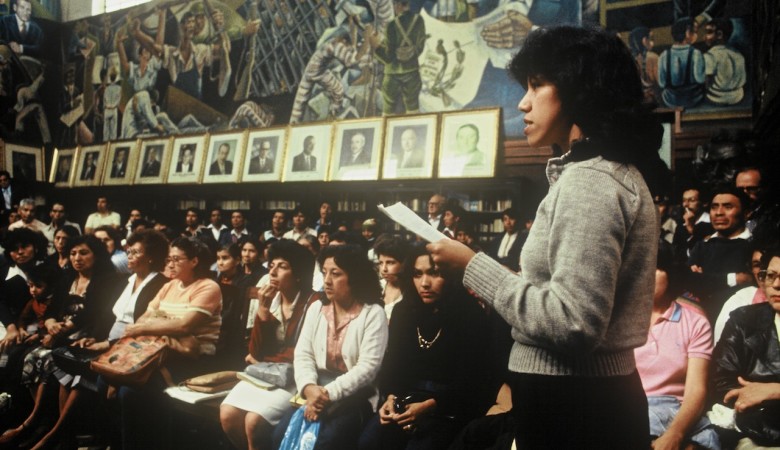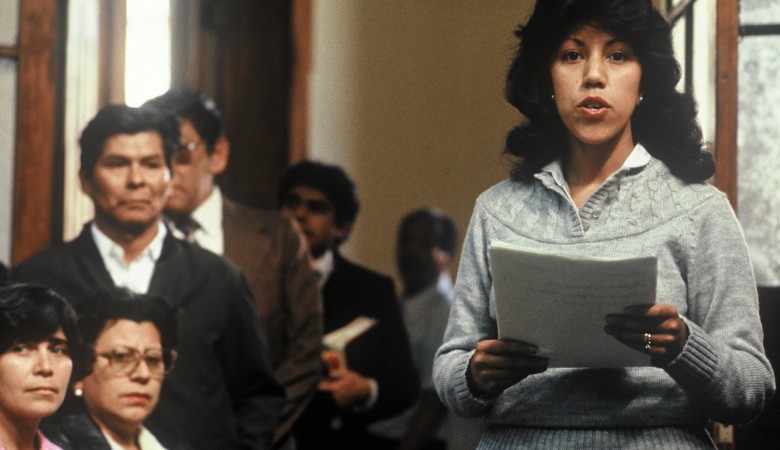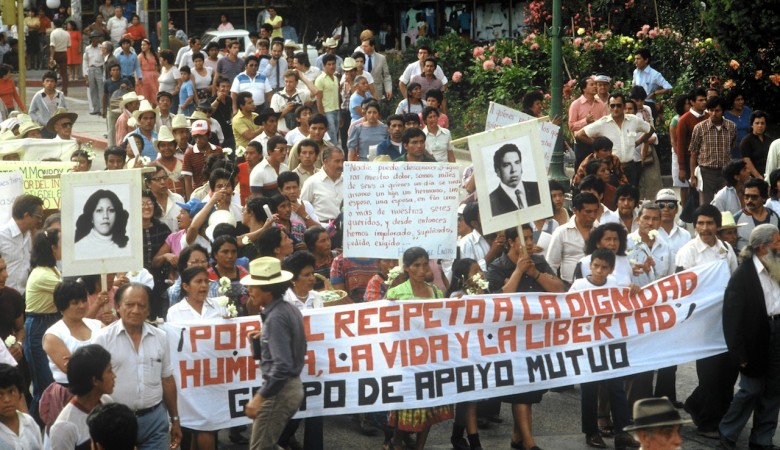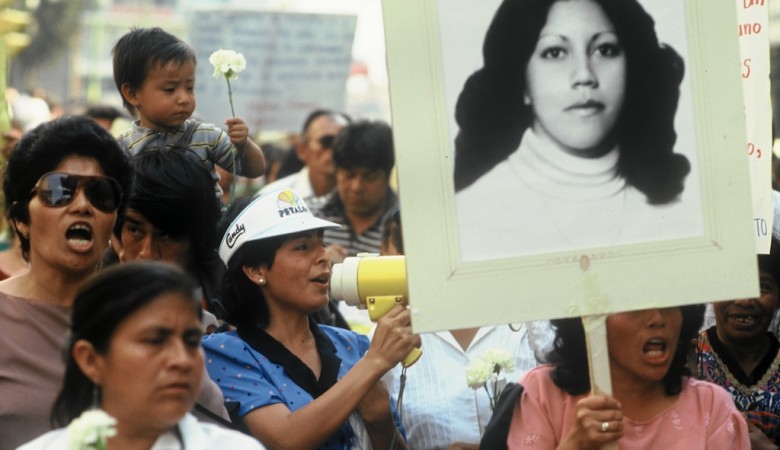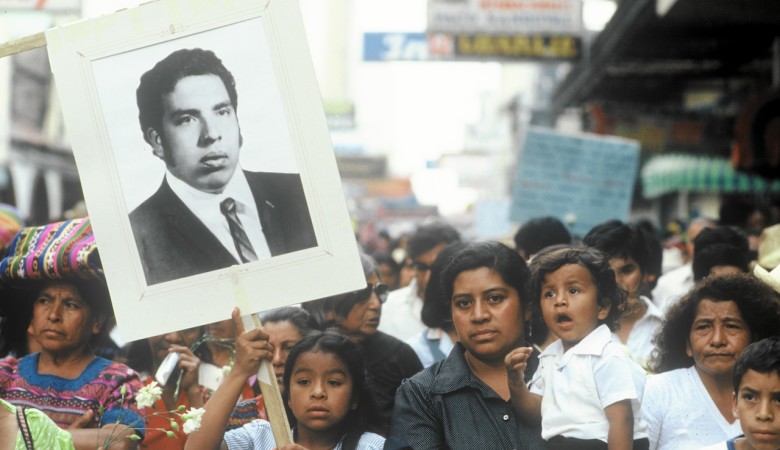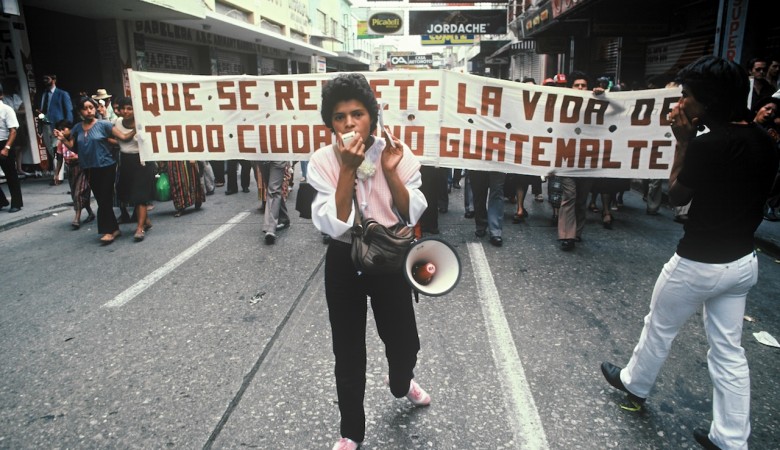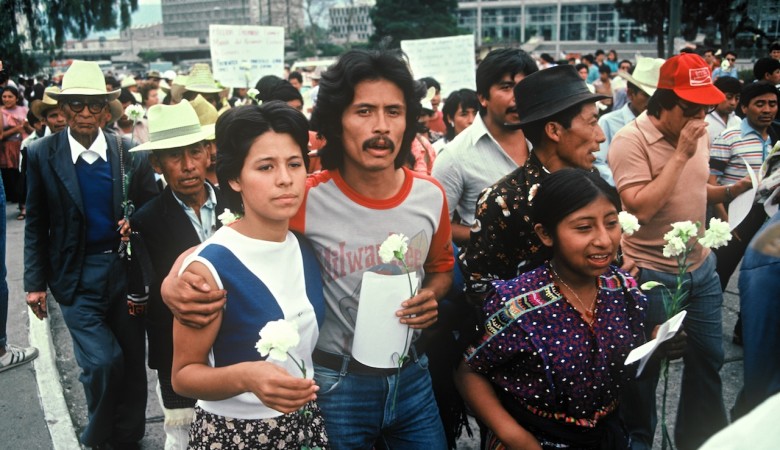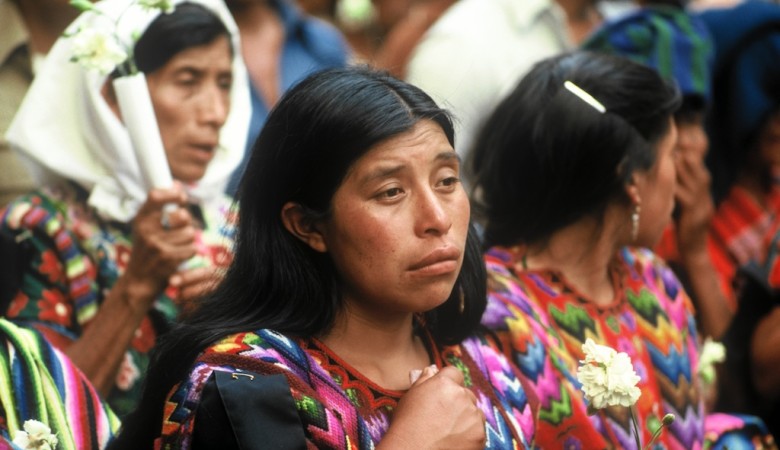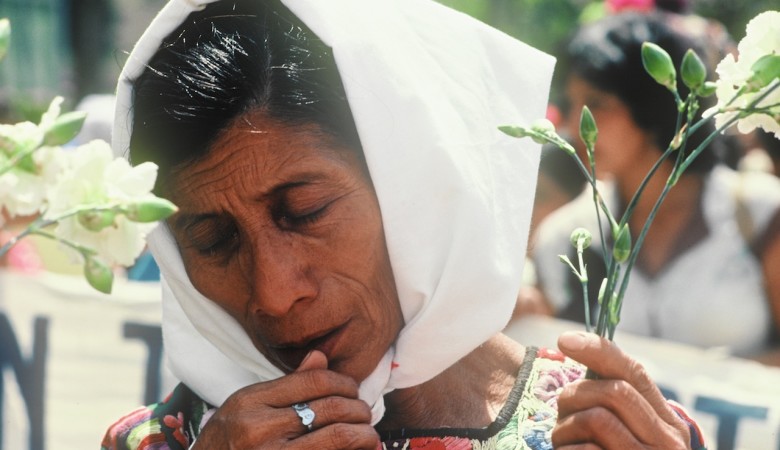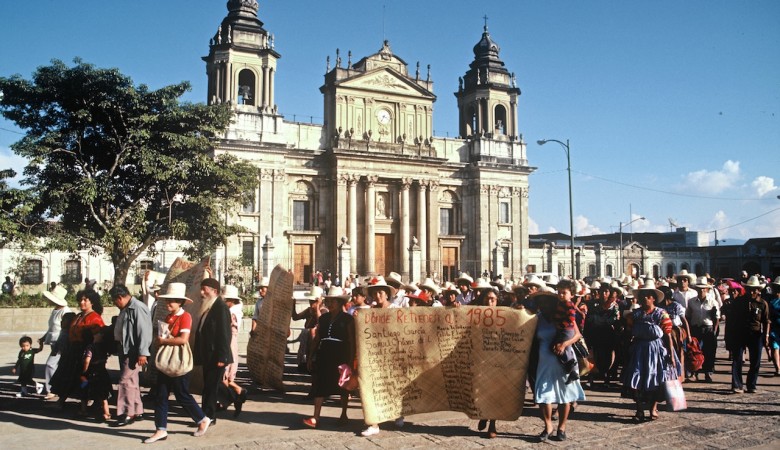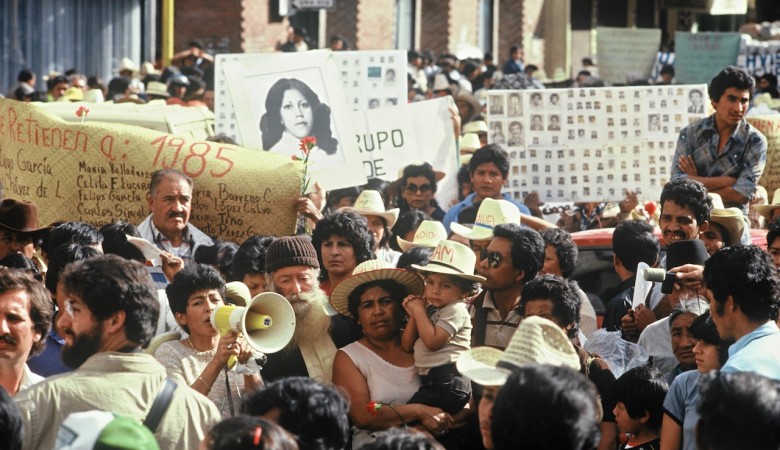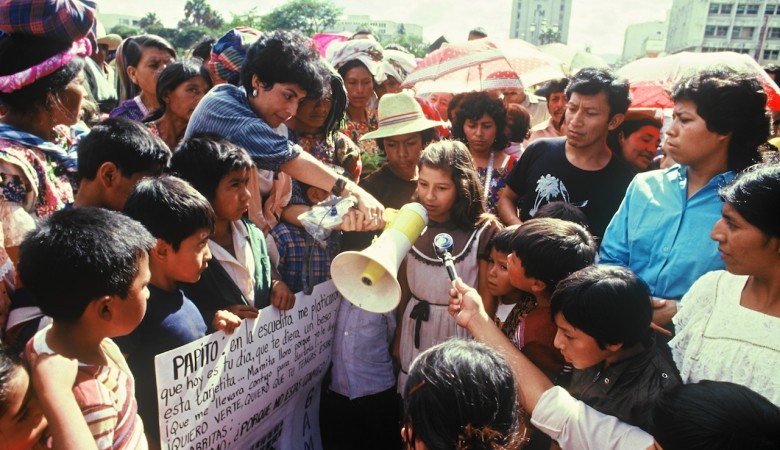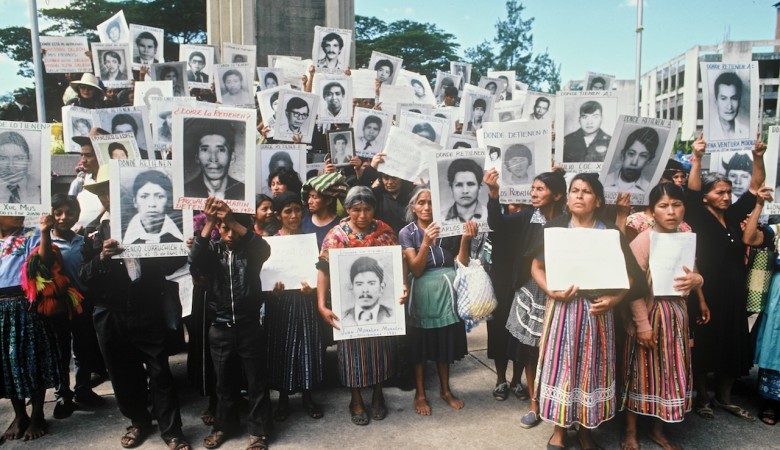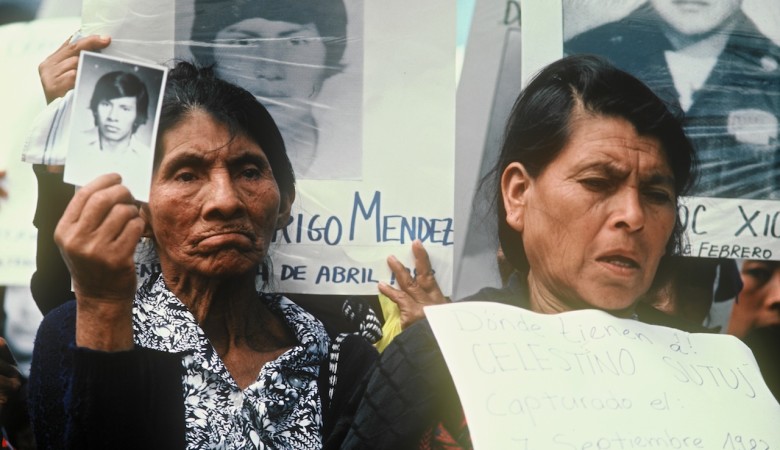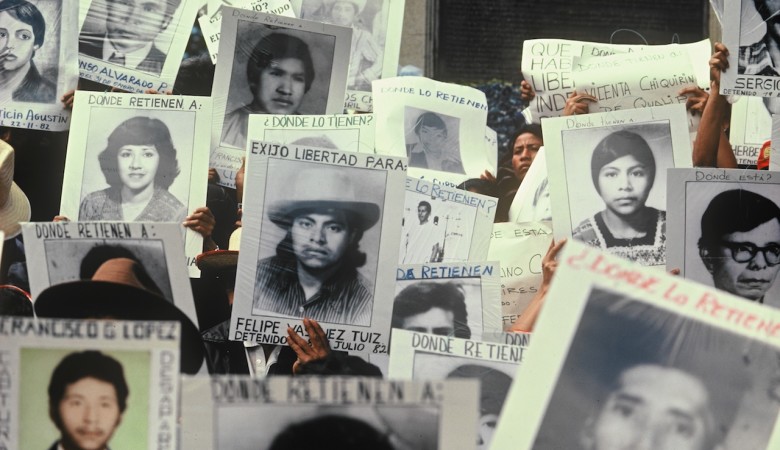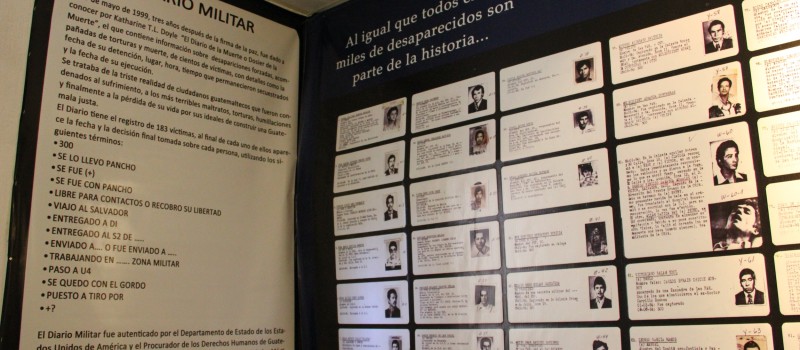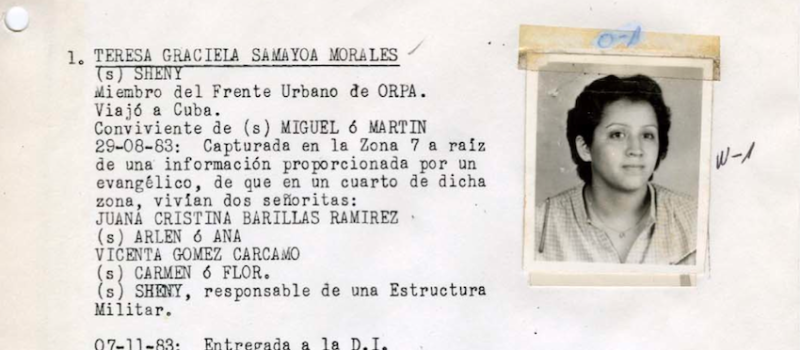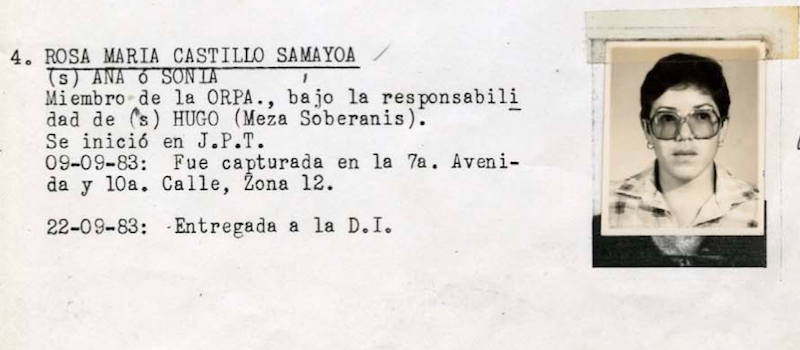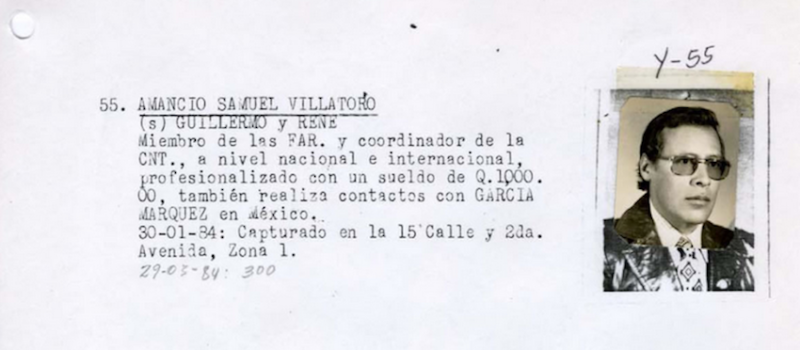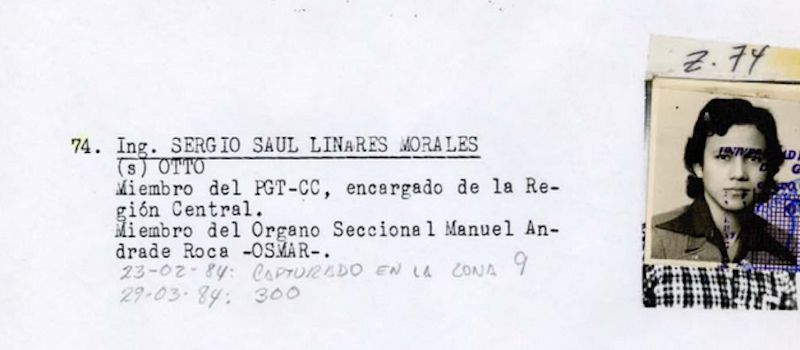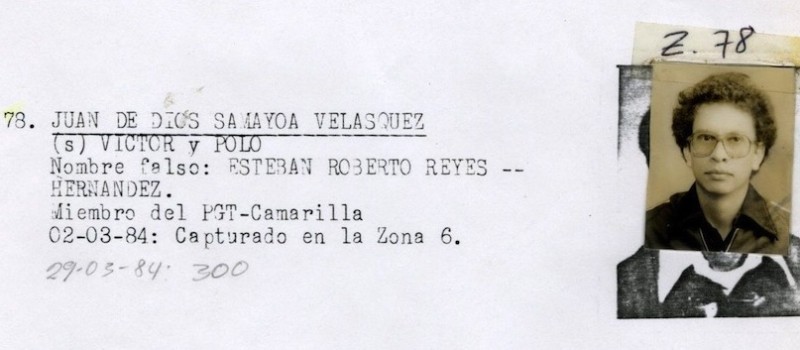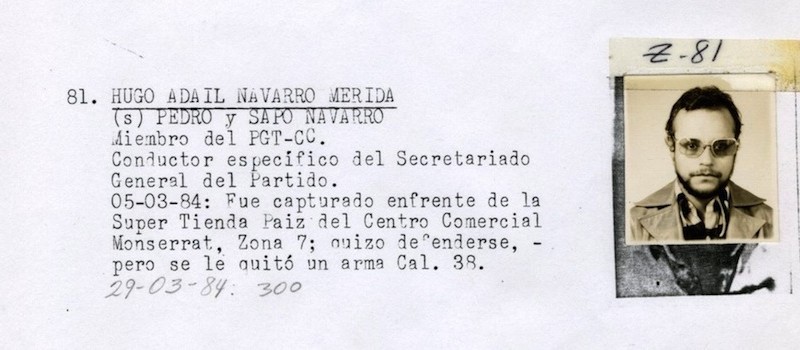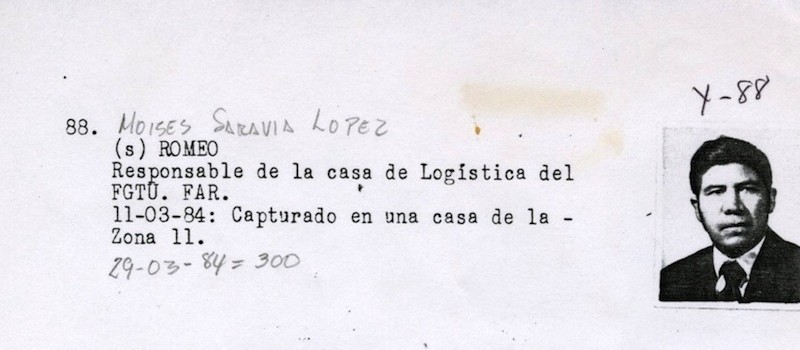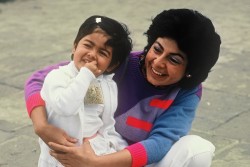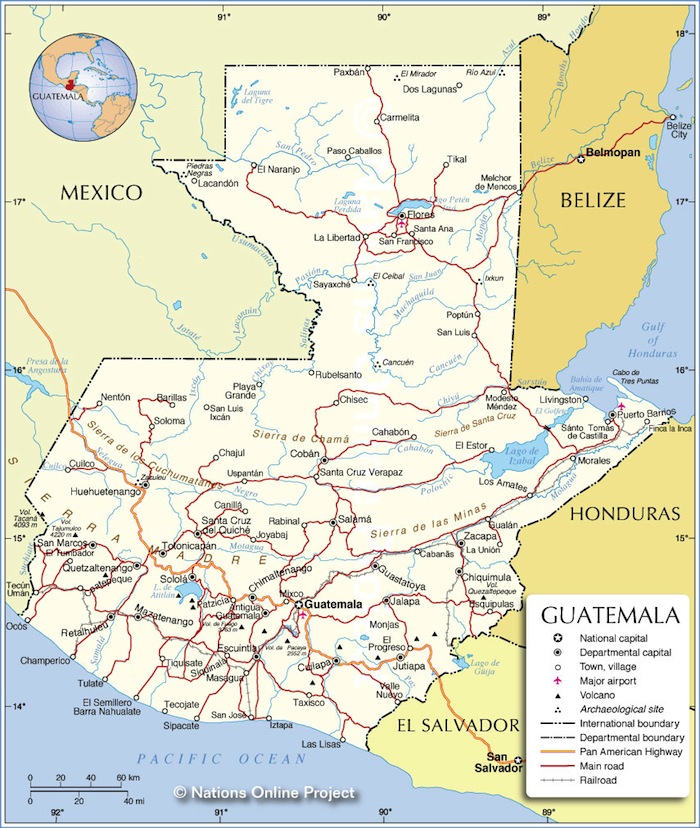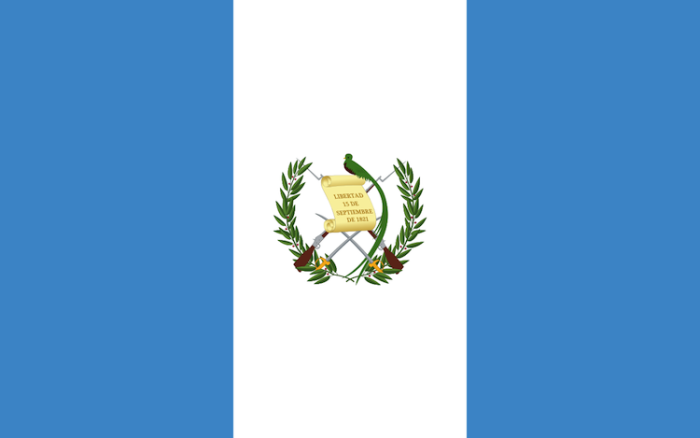Why Were Civilians Hit the Hardest?
The Guatemalan civil war (1960 -1996) pitted the guerrillas or insurgents against a series of oppressive military regimes they sought to overthrow. The government army and security forces, in turn, launched a counter-insurgency campaign to defeat the guerrillas, who they labeled “subversives.” In order to win the war, the army not only turned their sights on the armed combatants, but went after the actual or perceived civilian base of support as well, including men, women and children.
The army deliberately magnified the military threat of the guerrillas in order to rationalize their response, which was to terrorize and destroy all opposition. In “Guatemala: Memory of Silence,” members of a United Nations sponsored Truth Commission wrote: “The inclusion of all opponents under one banner, democratic or otherwise, pacifist or guerrilla, legal or illegal, communist or non-communist, served to justify numerous and serious crimes.” That helps explain why the vast majority of victims were civilians, not combatants.
A key element of the counter-insurgency campaign was gaining control of the civilian population, whether in Guatemala City where uprisings of peasant, student, labor and other social movements challenged the regimes, or in the predominantly Maya highland region where the guerrillas were most active. People’s daily activities were monitored through surveillance and military checkpoints. The creation of a system of civil patrols allowed the army to forcibly engage much of the rural male population in the fight against the guerrillas. (See Diego: “Who Killed Diego’s Father?”)
Violence and fear were potent weapons that the army used to obtain control. The Catholic Church’s Historical Memory Project (REMHI) concluded: “During the early eighties, a climate of terror spread across the country, characterized by extreme violence against communities and organized movements against which the people were completely defenseless. An atmosphere of constant danger totally disrupted the daily life of many families. Whether in the form of mass killings or the appearance of corpses bearing signs of torture, the horror was so massive and so flagrant that it defied the imagination.”
Former dictator Gen. Efraín Ríos Montt, who ruled in the early 1980s during one of the bloodiest periods of the war, justified the military’s actions toward the civilian population by paraphrasing Chinese revolutionary Mao Zedong: “The guerrillas are the fish; the people are the sea. If you want to catch the fish, you have to drain the sea.” Ríos Montt was found guilty of genocide against the Ixil-Maya people in a landmark lawsuit in Guatemala in 2013. (See Sebastián: “Was Anyone Punished for the Massacre?”)
“Draining the sea” was the objective of the scorched earth policy implemented by Ríos Montt in the highlands that resulted in the obliteration of entire Maya villages and their inhabitants (over 600 massacres). This is why Dora says the indigenous communities were the most persecuted and “left the most dead along the way.” The Truth Commission reported that 83% of the victims in the war were Maya and attributed 93% of overall human rights violations and acts of violence to state forces and paramilitary groups and 3% to the guerrillas.
The United States government bears some responsibility for the terror unleashed against the Guatemalan people. They had intervened in Guatemala’s affairs over many decades, often doing so covertly through the Central Intelligence Agency (CIA) and justifying their actions in the name of anti-communism. Funds for military aid and training flowed to Guatemala as well, in addition to economic aid, although the US Congress at times placed some restrictions due to the grave violations of human rights.
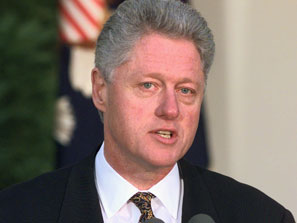
“It is important that I state clearly that support for military forces and intelligence units which engaged in violence and widespread repression was wrong, and the United States must not repeat that mistake.” President Bill Clinton speaking in Guatemala, 1999.
The Truth Commission report concluded that the “vital support” that the US gave to the military regimes had a “significant bearing on human rights violations during the armed confrontation.” A month after the report’s release, in March, 1999, during a visit to Guatemala, US president Bill Clinton apologized for the US actions.
SOURCES & LINKS
Broder, John. “Clinton Offers His Apologies to Guatemala.” New York Times, March 11, 1999.
http://www.nytimes.com/1999/03/11/world/clinton-offers-his-apologies-to-guatemala.html
Center for Justice and Accountability. “Genocide of Mayan Ixil Community.”
http://cja.org/what-we-do/litigation/the-guatemala-genocide-case/
Navarro, Mireya. “Guatemalan Army Waged ‘Genocide,’ New Report Finds.” New York Times, February 26, 1999.
http://www.nytimes.com/1999/02/26/world/guatemalan-army-waged-genocide-new-report-finds.html?pagewanted=all
ODHAG (Human Rights Office of the Archdiocese of Guatemala). Guatemala: Never Again! REMHI: Recovery of Historical Memory Project. Maryknoll, NY: Orbis Books, 1999.
Report of the Commission for Historical Clarification. “Guatemala: Memory of Silence,” Conclusions and Recommendations. 1999.
https://hrdag.org/wp-content/uploads/2013/01/CEHreport-english.pdf
Reynolds, Louisa. “Why did war-torn areas vote for Pérez Molina?” Latinamerica Press, December 7, 2011.
http://lapress.org/articles.asp?art=6531
What Does It Mean To Be Displaced?
A central experience of the Guatemalan people during the war was being displaced. Dora and her family were just a few of the estimated one million people (out of about 7 million total population at that time) who left their communities but stayed inside the country, called the internally displaced. Approximately 350,000 other people found their way to either Mexico or the US, most without legal documentation. Estimates suggest that up to 80% of people in areas most affected by the war – which includes Dora’s hometown – were displaced. “It was a veritable exodus of the population,” concluded the Catholic Church’s Historical Memory Project (REMHI) report.
Like Dora’s family, most people fled their homes and communities as they felt direct or indirect threats to their safety. In 1980, when Dora was just four months old, her parents left their small village to go to Guatemala City, leaving behind their house, crops, land, extended family and community. It would be over a decade before they dared to return just for a visit.
Fear and suffering characterized displaced people’s lives, as they were forced to live in substandard conditions, while they tried to find work to sustain them. Many lost their identification documents and were unable to replace them, making their access to work, schools and health care all the more difficult. People from the most conflictive areas, especially the Maya like Dora’s family, often hid their real identity because the government and media painted them as being “subversive.” Dora’s mother changed her Maya clothing – the designs often identify one’s place of origin – and her parents told others they’d moved to the city to seek work. Perhaps that is why twelve year old Dora says, “The Maya here are afraid to say who they really are.”
After their initial difficulties, Dora’s family fared better than many others who were displaced. Her father was a lay religious instructor and leader and their involvement with the local Catholic church helped integrate them into the larger community. He also was active in CONDEG, the National Council of Displaced Guatemalans, a grassroots organization that worked to heal the “open wounds” of those forcibly displaced by validating their experiences and advocating on their behalf in obtaining identity documents, land and work. Dora accompanied her father to many meetings, where she met a diverse group of people, and began to understand the larger context in which her family’s personal experience of displacement had taken place.
Moving to the city also gave Dora and her siblings greater access to education than they would have had living in a small rural village. All of them have earned university degrees.
Dora always seems to be in motion. She teaches in the morning and after returning home, she often helps out at the small store her family runs out of their house. In mid-afternoon, she boards a bus for the two hour ride to the university, where she’s studying for a second degree at night.
Dora is ever optimistic about not only her own future but also that of Guatemala, while acknowledging the serious problems that confront the country.
Guatemala is tarnished by gangs, drug traffickers, crime and corruption, which have been a major force driving a new wave of displaced people who – like those who fled during the war – believe they must leave their homes and communities in order to be safe. Some find another home within the country, but many thousands have also come to the US in recent years. Like Dora and her family, most people stay and go about their lives as best they can.
SOURCES & LINKS
CONDEG (National Council of Displaced of Guatemala)
http://condegguatemala.blogspot.com/
Costello, Patrick. “Guatemala: Displacement, Return and the Peace Process.” WRITENET, April 1, 1995.
http://www.refworld.org/docid/3ae6a6b98.html
ODHAG (Human Rights Office of the Archdiocese of Guatemala). Guatemala: Never Again! REMHI: Recovery of Historical Memory Project, Maryknoll, NY: Orbis Books, 1999
What Is A Disappeared Person?
In the context of the Guatemalan (and Salvadoran) war, to “be disappeared” meant to be kidnapped, interrogated, tortured and executed. Military forces, police or death squads carried out the disappearances. Victims were forcibly captured, often in broad daylight from city streets or rural villages as they went about their daily lives. Some were dragged out of their homes or workplaces. They were never formally arrested nor charged with any crime. The authorities simply denied they were involved, leaving family members without legal recourse to search for their loved one.
Amnesty International estimates that approximately 45,000 Guatemalans were disappeared during the civil war, the vast majority between 1978 -1983. They were students, teachers, peasant and labor leaders, health workers (like Dora’s uncles), lawyers, journalists, religious and community leaders. Some supported the armed struggle; many were involved in political organizations opposing the government or in social movements seeking economic and political reforms, which brought them to the attention of authorities. Others might simply have been denounced by a neighbor as being “subversive,” which was enough to insure their fate. Some had been followed for years before being picked up. They were simply made to vanish.

Excerpt from “Dirty Secrets: Jennifer, Everardo & the CIA in Guatemala” about having a disappeared loved one.
The Guatemalan regimes used disappearances as a weapon of terror. Their objective was to keep people frozen in fear. Had they simply wanted to control people they claimed were involved in “subversive” activities, they could have arrested and jailed them. Instead, their actions were designed to be a kind of slow torture for the family and friends of the disappeared, who were kept in a state of extreme fear and anxiety, wondering who would be next, or if they could be doing more to find their loved one, and never being able to fully grieve their loss nor give the person a proper burial.
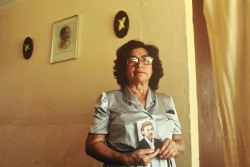
Ester Herrarte stands in the living room where her son Jorge, in the photograph, was abducted in 1983.
In 1984, a small group of relatives of disappeared people, who became acquainted while searching for their loved ones, formed the Mutual Support Group, known as GAM (Grupo de Apoyo Mutuo). They began to denounce the disappearances in press conferences and newspapers. As their numbers grew they demonstrated in the streets, shouting “You took them alive, we want them back alive.” The GAM was one of the first human rights organizations in Guatemala. At times, Guatemalan government officials reluctantly agreed to meet with them, but none gave them any real information.
Members of the GAM took great risks coming out in public to denounce the disappearances and point a finger at the government. GAM members often received death threats. In the spring of 1985 two GAM leaders (and the brother and two year old son of one of them) were tortured and killed in separate incidents. Shocked and grieving, the GAM carried on, and more people than ever, including many peasants who had traveled from distant towns in the countryside, peacefully marched through Guatemala City two weeks later.
Over the years, GAM and a sister organization called Relatives of the Detained and Disappeared of Guatemala or FAMDEGUA (Asociación Familiares de Detenidos-Desaparecidos de Guatemala) have kept up the pressure on the government to acknowledge the truth about what happened to their loved ones and bring the perpetrators of the disappearances to justice. Both organizations have lobbied for exhumations, declassification of government documents and helped bring lawsuits in Guatemalan courts and international tribunals to hold those responsible accountable.
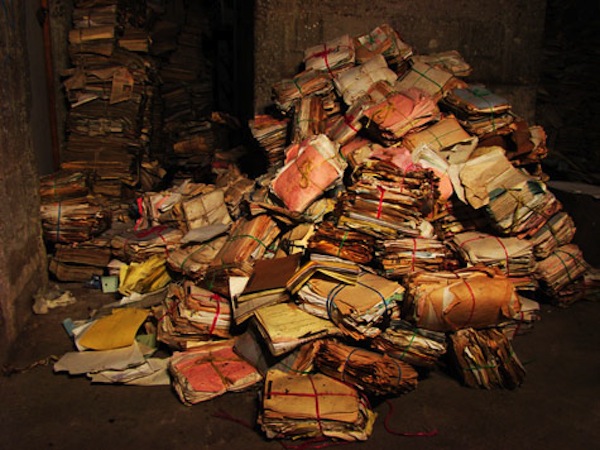
A few of the millions of documents that were later painstakingly cleaned and organized into the Historical Archive of the National Police (AHPN). Photo courtesy of AHPN.
Little by little, the truth is coming out. In 1999, a “Death Squad Diary” (Diario Militar) was smuggled out of the country detailing the fate of 183 disappeared people (see excerpts below). Revelations contained in the millions of documents recovered from the National Police Archives in 2005 shed light on hundreds of individual cases of disappeared people, as well as on the overall practice. Identifying human remains exhumed from hundreds of clandestine cemeteries, many on or near former military bases, also has proven the fate of many disappeared people, through DNA matches, allowing their families to properly bury their loved ones. (See Diego: Who Is Digging?)
As the truth slowly emerges, justice has been achieved in a handful of notable court cases. FAMDEGUA worked for a decade to bring the perpetrators of a 1982 massacre in the town of Dos Erres to justice. Finally, in 2011, four former soldiers from an elite Army contingent were found guilty in the murder of 201 people. They each received prison sentences for over 6000 years. It was the first time in the Guatemalan courts that anyone was held responsible for a massacre.
In October, 2010, a Guatemalan court sentenced two former low ranking National Police officers to 40 years in prison each for the disappearance of Edgar Fernando García, a trade union leader, in 1984. (His wife, Nineth Montenegro, was one of the founders of GAM.) García’s daughter Alejandra, who was an infant when he was disappeared, read the following statement at his trial: “I do not seek revenge, neither would my dad have, but I do seek the truth, I want to know where he was taken, I want to know why he wasn’t formally charged, I want to know who gave the order, I want to know … who he was handed over to, I want to know what happened to him. My heart cannot rest and be at peace without the truth, as harsh as it may be, the truth always heals the soul.”
SOURCES & LINKS
Amnesty International News. “City of the Disappeared – three decades of searching for Guatemala’s missing.” November 19, 2012.
http://www.amnesty.org/en/news/city-disappeared-three-decades-searching-guatemalas-missing-2012-11-19
Asociación Familiares de Detenidos – Desaparecidos de Guatemala – FAMDEGUA
https://www.facebook.com/famdegua.guatemala
Digital Archive of the Guatemalan National Police Historical Archive.
https://ahpn.lib.utexas.edu/
Doyle, Kate. “Death Squad Diary.” Harper’s Magazine, June 1999.
http://www2.gwu.edu/~nsarchiv/NSAEBB/NSAEBB15/death_squad_harpers.pdf
Goudvis, Patricia. “Dirty Secrets: Jennifer, Everardo & the CIA in Guatemala.” New Day Films, 1995.
https://vimeo.com/199361730
Grupo de Apoyo Mutuo – GAM
https://www.facebook.com/GAMGuatemala/
Guatemala Human Rights Commission/USA. “GHRC Congratulates FAMDEGUA on 22 Years of Searching for Truth, Justice, and Memory.” Monitoring Guatemala, June 18, 2014.
https://ghrcusa.wordpress.com/2014/06/18/ghrc-congratulates-famdegua-on-22-years-of-searching-for-truth-justice-and-memory/
––––––. “Dos Erres Massacre.”
http://www.ghrc-usa.org/our-work/important-cases/dos-erres-massacre/
National Security Archive. “Guatemalan Death Squad Dossier.”
http://www2.gwu.edu/~nsarchiv/NSAEBB/NSAEBB15/
––––––. “27 Years Later, Justice for Fernando García.”
http://nsarchive2.gwu.edu/NSAEBB/NSAEBB337/
ODHAG (Human Rights Office of the Archdiocese of Guatemala). Guatemala: Never Again! REMHI: Recovery of Historical Memory Project, Maryknoll, NY: Orbis Books, 1999.
Watch More of Dora
Guatemala Maps & Facts
Size: 41,699 sq. miles, size of Tennessee
Population: 15,470,000 (2013)
Capital: Guatemala City
People: Over half are indigenous Maya; the rest are primarily of mixed Maya and Hispanic heritage, called Ladinos; small population of African descendents (including Garifuna) along Atlantic Coast
Languages: Spanish is the official language; there are 22 Mayan languages spoken as well as Xinca and Garifuna
Religions: Roman Catholic, Protestant (primarily evangelical) and Maya
Independence: 1821 (from Spain)
- Over half the population lives below poverty level.
- Illiteracy, infant mortality and malnutrition rates are among the highest in Latin America.
- Life expectancy is among the lowest in Latin America.
- Nearly one third of all children do not complete primary school.
- All social indicators are worse for the Maya population than for the Ladino.
- The country is plagued by gang and drug related violence and organized crime. It serves as a major corridor for drugs coming to the US from South America.
Quick Facts About the War
Dates: 1960 – 1996 (36 years)
In 1982, the four most important Guatemalan revolutionary organizations fighting against the military regimes and paramilitary right-wing groups created the Guatemalan National Revolutionary Unity (URNG).
Over 200,000 people were killed or disappeared
1.5 million were displaced
669 massacres
83% of victims were Maya & 17% of victims were Ladino
The Turth Commission found that Army and security forces were responsible for 93% of atrocities; the insurgency (guerrillas) for 3%; the remaining 4% were undetermined.
Historical Timeline
2500 BCE – 1501 CE - Maya civilization begins around 2500 BCE and reaches its peak of development beginning around 200 CE. Maya achievements in mathematics, astronomy, architecture, engineering, art, language and agriculture are notable. Around 900 CE Maya cities suffer a decline.
1501 – 1821 – Spanish conquerors began sweeping through the continent. Between 1524 and 1650, about 85% of Maya are killed by weapons and diseases. Many survivors are enslaved, but some flee to the higher mountains. Ceremonial centers are torn down and replaced with Christian churches. Maya leaders and scholars are killed, writings are destroyed.
1821 – 1900 – On September 15, 1821, Guatemala declares independence from Spain. From 1823 -1840, it is part of the United Provinces of Central America (along with El Salvador, Honduras, Nicaragua and Costa Rica). In 1947, Guatemala declares itself an independent republic. Conservatives and Liberals dominate Guatemalan (and Central American) politics. Conservatives represent the interests of wealthy landowners and the Catholic Church, favoring strong central government and a regulated economy. Liberals represent mainly the middle class and merchants, favoring decentralized government, free trade and greater separation of church and state. During the mid-1800s, cultivation and export of coffee creates a new oligarchy of wealthy families.
1900 – 1944 – By 1900, the United States is the dominant economic force in Guatemala. The United Fruit Company becomes the largest landowner, employer and exporter in Guatemala, persuading the government to provide them with land, low taxes and cheap labor. While United Fruit’s profits flourish, most the population suffers malnutrition, high rates of infant mortality, limited access to health care and education and violations of human rights. This leads to wide-scale discontent. The middle class also is frustrated with its own limited economic growth and political power.
1944 – 1954 – Ten-year period of social and democratic reforms, including establishment of a social security system, minimum wage, the legalization of unions, laws to protect workers and national health care. The United Fruit Company and other large landowners threatened by land reform which redistributes their unused lands to landless peasants.
1954 – CIA led coup, promoted by United Fruit and “justified” with Cold War rhetoric, replaces freely elected President Jacobo Arbenz with Colonel Carlos Castillo Armas. The coup is a turning point in modern Guatemalan history, paving the way for decades of repressive military dictators. Castillo repeals the land reform law, represses labor unions and reverses most other social reforms. Widespread crackdown on labor leaders and peasants.
1960 – The beginning of Guatemala’s civil war between government military forces and primarily left-wing insurgents. Peasant, student, community, labor, church and other groups organize and protest nonviolently in the streets. The government responds with increasing repression, using military as well as paramilitary forces, that become known as death squads. In the following two decades, as repression continues, armed insurgents known as guerrillas gain strength, especially in the Maya highland region.
1976 – A severe earthquake kills over 25,000 people and leaves a million homeless, exposing massive social inequities. Anti-government organizing activities increase.
1978 – General Romeo Lucas García becomes president in openly rigged election. Protests and strikes erupt and student and labor leaders, even priests, are assassinated. Peasant groups are massacred.
1982 – Four guerrilla organizations form the Guatemalan National Revolutionary Unity (URNG).
General Efraín Ríos Montt seizes power in a coup and escalates the repression into a “scorched earth” campaign, aimed primarily at certain Maya highland regions where the guerrillas are active.
1983 – Ríos Montt is ousted by General Oscar Mejía Víctores but the bloodshed continues. Terror is everywhere as thousands of people are killed or disappeared. Entire villages are massacred, including men, women and children.
1986 – Vinicio Cerezo, a civilian, assumes the presidency following a legitimate election. The violence diminishes, but does not stop, as the military still wields great power.
1992 – Rigoberta Menchú, a defender of human and Maya rights, wins the Nobel Peace Prize.
1996 – The 36-year long civil war formally ends with a Peace Agreement.
1998 – Bishop Juan Gerardi is assassinated two days after presenting “Guatemala: Never Again!” a report by the Catholic Church on human rights violations during the war, which concludes that 90% were committed by government forces and their paramilitary bands.
1999 – The United Nations sponsored Truth Commission report states that 93% of all human rights violations during the civil war were committed by government security forces; that approximately 200,000 people were killed or disappeared; and that over 600 massacres were carried out.
2006 – Government and UN set up a commission known as CICIG to fight impunity by prosecuting high level criminals. Crime, social injustice and human rights violations continue to afflict Guatemala.
2009 – An ex-military officer and a retired colonel are the first people convicted of crimes committed during the civil war.
2013 – Following an historic trial, former President Ríos Montt is found guilty of crimes against humanity and genocide. Shortly thereafter, the Guatemala Constitutional Court annuls the judgment and orders a new trial.
2015 – Revelations by CICIG of governmental corruption provoke massive protests and demonstrations, resulting in the resignation of both the president and vice president, who are sent to prison. Former comedian Jimmy Morales, whose slogan is “not corrupt nor a thief,” is elected President.
2016 – Former military soldiers are convicted of sexual violence toward and enslaving 15 Maya women during the civil war.

